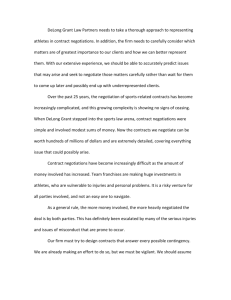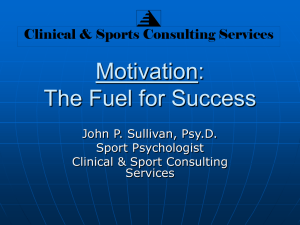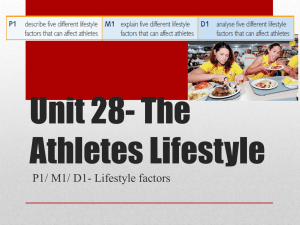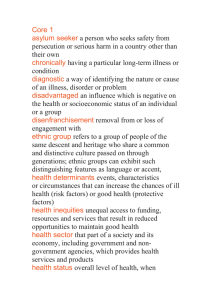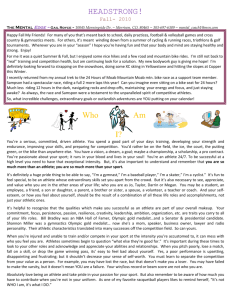Physiology of the Young Athlete
advertisement
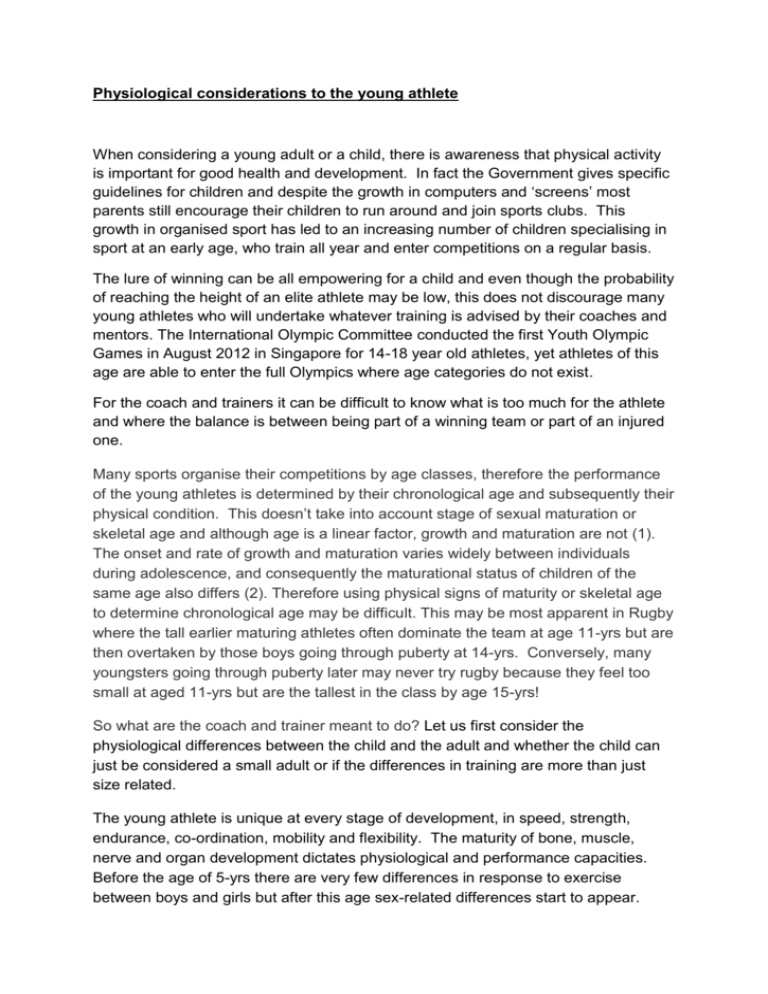
Physiological considerations to the young athlete When considering a young adult or a child, there is awareness that physical activity is important for good health and development. In fact the Government gives specific guidelines for children and despite the growth in computers and ‘screens’ most parents still encourage their children to run around and join sports clubs. This growth in organised sport has led to an increasing number of children specialising in sport at an early age, who train all year and enter competitions on a regular basis. The lure of winning can be all empowering for a child and even though the probability of reaching the height of an elite athlete may be low, this does not discourage many young athletes who will undertake whatever training is advised by their coaches and mentors. The International Olympic Committee conducted the first Youth Olympic Games in August 2012 in Singapore for 14-18 year old athletes, yet athletes of this age are able to enter the full Olympics where age categories do not exist. For the coach and trainers it can be difficult to know what is too much for the athlete and where the balance is between being part of a winning team or part of an injured one. Many sports organise their competitions by age classes, therefore the performance of the young athletes is determined by their chronological age and subsequently their physical condition. This doesn’t take into account stage of sexual maturation or skeletal age and although age is a linear factor, growth and maturation are not (1). The onset and rate of growth and maturation varies widely between individuals during adolescence, and consequently the maturational status of children of the same age also differs (2). Therefore using physical signs of maturity or skeletal age to determine chronological age may be difficult. This may be most apparent in Rugby where the tall earlier maturing athletes often dominate the team at age 11-yrs but are then overtaken by those boys going through puberty at 14-yrs. Conversely, many youngsters going through puberty later may never try rugby because they feel too small at aged 11-yrs but are the tallest in the class by age 15-yrs! So what are the coach and trainer meant to do? Let us first consider the physiological differences between the child and the adult and whether the child can just be considered a small adult or if the differences in training are more than just size related. The young athlete is unique at every stage of development, in speed, strength, endurance, co-ordination, mobility and flexibility. The maturity of bone, muscle, nerve and organ development dictates physiological and performance capacities. Before the age of 5-yrs there are very few differences in response to exercise between boys and girls but after this age sex-related differences start to appear. Figure 1: Windows of Accelerated Adaptation to Training (Balyi and Way, 2005)(3) During early and adolescent years muscles and bones grow quickly and are often more vulnerable to injury during this period. The bones are not yet fully ossified and repetitive strain on them can cause malformations and injury. Healing is quicker in the young athlete than the adult so injury time away from training can often be less. However with regular training muscles will develop more rapidly than the skeleton and can put an unusual stress on the skeleton. Muscle will also grow more quickly in the young athlete than in the non-athlete due to training loads and ironically can cause long term injuries that the sedentary adolescent will not be vulnerable to. The areas of most rapid growth velocity are usually the back and lower legs. These areas may show decreased muscle strength during this time of growth along with tightness and lack of neurological co-ordination in the changing muscles impacting on general co-ordination (eg hand eye coordination and response reflex) which may result in a higher risk of injury. For boys there will be an increase in strength once puberty has passed. This will be a marked change over a short period of time. Peak strength in boys will be around the age of 20-yrs and they can then build on this over a period of years to optimise peak strength and power once maturity is reached. Coordination will also change once puberty has been reached as until that time the myelination of the nerves is incomplete. Once this is achieved quicker muscle fibre recruitment is achieved. In girls the changes will be the same after puberty but there will be a more gradual change as the length from beginning to end of puberty is longer in girls. Cardio-vascular function will improve in a direct correlation to lung size, therefore the bigger the child the better the cardio-vascular function will be. Lung volume increases until growth is completed. No studies have directly compared a height and weight matched adult to that of a child in order to investigate whether lung function would be the same for the same size but it is presumed that the child with the smaller heart and lungs and less mature muscles would be at a disadvantage. However blood flow to active muscles during exercise can be greater than in adults because there is less peripheral resistance. In other words arteries and capillaries that carry the blood around the body during exercise are more able to get the blood and oxygen to the working muscle and allow a greater rate of perfusion. The child will have a smaller heart size and total blood volume and this may result in lower stroke volume, this is the amount of blood pumped out of the heart with each contraction. The consequence of this lower stroke volume is that the heart has to beat more quickly to get the same amount of oxygen saturated blood to the working muscle than a heart with a larger stroke volume. Therefore the heart rate at submaximal aerobic work will be higher in the young athlete than in an adult. As the increased heart rate cannot completely compensate for this lower stroke volume the cardiac output will be lower for the same absolute rate of work; the young athlete will find the same intensity of submaximal work harder than the adult. So what are the aerobic and anaerobic capabilities of the young athlete compared to the adult? Well, as discussed above their lung size and heart size will increase with growth; therefore the VO2max will also increase with growth. This lower VO2 should not disadvantage sports that use body weight for example running as relative VO2max should be similar to that of an adults. In other words the VO2 is relative to the body weight and per kilogram is similar to an adult. The young athlete will have a more limited ability to perform anaerobic type activities and cannot achieve adult concentrations of lactate in either muscle or blood for maximal and supramaximal rate of exercise. It has been suggested that this is due to lower levels of the enzymes needed to optimise glycolytic capacity and the amount of glycogen stored in the muscle (Armstrong et al 1994). This accumulation of lactate and therefore lower lactate threshold will occur at a lower running pace to that of an adult. Children cannot maintain as fast a running pace due to economy of effort and the lowered lactate threshold. Leg length and power will improve with both age and size, so it would be unlikely for the young athlete to be able to compete with an adult for stride length and explosive power such as sprint work. An interesting study by Cheung and Richmond (1995) looked at those physiological changes that occurred with age and those that occurred with training. The training moved the physiological adaptations towards those that occur with age, suggesting that the young athlete may reach physical maturity earlier than the sedentary child. Although this may be an advantage with some sports, for others physical maturity may have a negative impact on the sport. Physiological Function Change with age and maturation Change with training Maximal Heart Rate Decreases No Change Maximal Stroke Volume Decreases No Change Increases No change in boys Decreases in girls Increases Decreases Maximal ventilation Increases Increases Maximal blood and muscle lactate concentration Increases Increases Increases Increases Increases Increases Increases No change Increases Increases Maximal Oxygen Uptake In L/min In mL/kg/min Peak anaerobic power In watts In watts/kg Muscle strength In newtons In newtons/muscle size Age and maturation-related changes in physiologic functions that affect physical fitness . Adapted from Cheung & Richmond 2005 (4) So what are the training implications and considerations around these differences in young athletes? Well, although most substantial changes in VO2max occur after puberty, training does seem to improve running speed over that seen in the non-trained. Anaerobic training improves anaerobic capacity by increasing resting levels of energy substrates such as ATP, glycogen and phosphocreatine. In other words those that train reap the benefits and those that don’t won’t! Nothing different to the adult athlete when carrying out this type of training. However resistance training does have different implications for the young athlete. Historically the young athlete has been discouraged from free weights and resistance training for fear of injury. It was speculated that resistance training would have little effect on pre-pubescent boys because of the low levels of androgens and that the risk of injury was too high. In more recent years opinion has changed to the belief that correct resistance training may protect against injury by strengthening muscles across a joint but a conservative approach is still recommended, particularly in the pre-adolescent. The Committee on Sports Medicine and Fitness (5) advises that young athletes should avoid competitive weight lifting and power lifting until skeletal maturity is reached; that moves should be learnt initially without weights and that all major muscle groups should be included in the training with the joint going through the full range of movement. A review by Faigenbaum and Myer (6) looked at resistance training in young athletes and reported upon the injuries and safety of such training. They concluded that the current research indicates that resistance training can be a safe effective and worthwhile activity for children and adolescents provided that qualified professionals supervise all training sessions and provide age-appropriate instruction on proper lifting procedures and safe training guidelines. A final aspect of the young athlete’s differences to the adult athlete is that of nutrition and hydration. In an adult 2% dehydration will decrease endurance and work capacity. For the child it only takes 1% decrease in bodyweight from exercise induced sweating to decrease endurance capacity in children. This changes once adolescence is reached. To compound the problem of dehydration is the problem of thermal stress. In the child the sweat glands produce sweat more slowly giving a lower capacity for evaporation and therefore body cooling. The young athlete will also have greater peripheral vasodilation allowing for more loss of heat through convection and radiation, which are not as efficient for cooling as evaporation. In order to hydrate it is recommended that an adult has 2-3 litres of fluid a day, approximately 500ml for each 500kcal of energy. This has been determined via tracer methods where the water is made ‘heavy’ with a radioactive molecule so that its pathway through the body can be seen. In children studies have only looked at amount of fluid taken in versus amount of fluid excreted. Ballauff et al (7) estimated that children aged from 6-11 years would only need 1.6 litres per day and after this age they would need the same as adults. For energy intake and the macronutrients COMA (8) have recommended the following:Male Female Male Female 11-14yrs 11-14yrs 15-18yrs 15-18yrs Energy intake 2220 Kcal/d 1845 Kcal/d 2755 Kcal/d 2110 Kcal/d Protein 42.1g/d 42.1g/d 55.2g/d 45g/d CHO 50% TOTAL ENERGY INTAKE Fat 35% TOTAL ENERGY INTAKE Table 1 Energy and macronutrient intakes in children. Adapted from COMA 1991 (8) But examination of these recommendations allows for some criticism. The Reference Nutrient Intake (RNI) for protein for an 11-14 year old male is 42.1g/d. Yet the guidelines recommend 12-15% of daily intake to come from protein for an adult, or approximately 1.4g/kg/d for an adult undertaking endurance exercise. A child would need at least as much as an adult if not slightly more if they are still growing. So if we look at the table above it can be seen that energy intake for a 14 year old male is recommended at 2220 kcal/d. Fifteen percent of this is 331k/cal. If this is then divided by 4 to give us the grams of protein needed to obtain 331 k/cal per day we get 83g of protein compared to the 42.1g recommended. Therefore the recommendations are not high enough especially for the young athlete who is training most days. The better option is to take the weight of the young athlete and multiply this by 1.4 to get the total amount of protein in grams needed per day. A 45Kg athlete would therefore need 63g protein per day (45x1.4). In conclusion, there is no definitive answer as to whether the young athlete is just a small adult. Some of the issues for the young athlete are around size but other issues such as glycolytic enzymes and lactate clearance along with strength and sweat differences will affect performance. It can be seen that training will have the required beneficial effects on performance and for this reason the young athlete must be directed to continue their training but rest and recovery is paramount to keep the young athlete healthy and a variety of training must be considered in order to avoid overuse injuries. References 1 Malina RM et al (2004). Maturity-associated variation in the growth and functional capacities of youth football (soccer) players 13–15 years. Eur J Appl Physiol. 91:555–62. 2 Mirwald RL et al (2001). An assessment of maturity from anthropometric measurements. Med Sci Sports Exerc; 34:389–94. 3 Balyi I et al (2005). Canadian sport for life: Long‐term athlete development resource paper. Vancouver, BC: Canadian Sport Centres. 4 Cheung LW & Richmond JB (1995). Child Health, Nutrition and Physical Activity, Human Kinetics. Champaign Il USA p101 5 Committee on Sports and Medical fitness (1995). Intensive training and Sports Specialization in Young Athletes. Pediatrics. www.pediatrics.org /cgi/content/full/106/1/154 (accessed Oct 2012) 6 Faigenbaum and Meyer 2010. Resistance training among young athletes: safety efficacy and injury prevention effects. Br J Sports Med 44 56-63 7 Ballauff A et al (1988). Do children have an adequate fluid intake? Water balance studies carried out at home. Ann Nutr Metab 32:332–339. 8 COMA (1991) Report on Health and Social Subjects 41 Dietary Reference Values (DRVs) for Food Energy and Nutrients for the UK, Report of the Panel on DRVs of the Committee on Medical Aspects of Food Policy (COMA) . The Stationary Office. London




